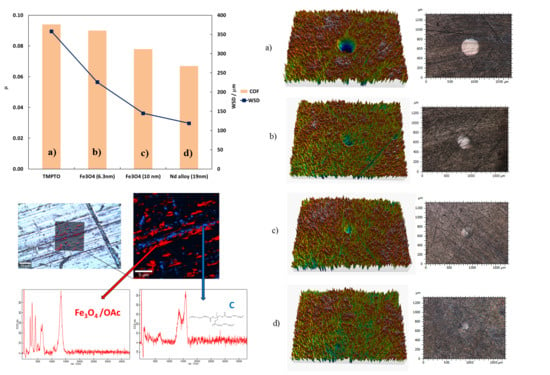Tribological Behavior of Nanolubricants Based on Coated Magnetic Nanoparticles and Trimethylolpropane Trioleate Base Oil
Abstract
:1. Introduction
2. Materials and Methods
2.1. Base Oil
2.2. Synthesis and Characterization of Nanoparticles
2.2.1. Chemical and Materials
2.2.2. Synthesis
2.3. Preparation of the Nanolubricants
2.4. Tribological Behavior: Ball-on-Three-Pins Test
2.5. Film Thickness Measurements
2.6. Tribological Behavior: Stribeck Curves
2.7. Rolling Bearing Test Rig
3. Results
3.1. Stability of the Nanolubricants
3.2. Friction Behavior in Ball-on-Three-Pins
3.3. Surface Analysis of Worn Pins
3.4. Film Thickness
3.5. Friction Behaviour: Stribeck Curves
3.6. Friction Behavior: Rolling Bearing Test Rig
4. Conclusions
- -
- Magnetic nanoparticles: Fe3O4 (6.3 nm), Fe3O4 (10 nm) and Nd alloy (19 nm) functionalized with oleic acid have been synthesized.
- -
- Dispersions of TMPTO base oil with 0.015 wt% of Fe3O4 (6.3 nm), Fe3O4 (10 nm) and Nd alloy (19 nm) were prepared showing that through chemical modification with oleic acid, a greater stability of the nanodispersions is achieved, which can validate their use for many industrial applications. This is one of the highest time stabilities in the literature for nanolubricants [15].
- -
- For pure sliding/boundary tests at 20 °C, for the three nanolubricants the friction coefficient is lower than that obtained with the base oil, the best friction behavior being obtained with the Nd alloy nanolubricant with a friction reduction of 29% in comparison with the base oil.
- -
- The diameters and depths of the wear scar obtained with the three nanolubricants are lower than those corresponding to the base oil, obtaining maximum wear reductions for the Nd alloy nanolubricant, being 67% and 35% in terms of diameter and depth of the wear scar, respectively
- -
- Protective tribofilm formation was confirmed by confocal Raman microscopy on the worn surfaces.
- -
- Film thickness values for all studied nanolubricants are very similar due to their similar viscosities, so lubrication capacity will be analogous for all lubricants.
- -
- Under rolling conditions of 5% SRR and 30 °C, the full Stribeck curves for all lubricants are similar whereas at the higher temperatures the Fe3O4 (6.3 nm) nanolubricant shows lower friction coefficient than the base oil and the other nanolubricants.
- -
- Fe3O4 (6.3 nm) nanolubricant leads to a lower friction torque in comparison with the base oil, especially at low speed when the film is thin and the nanoparticles play an important role in the reduction of friction.
Supplementary Materials
Author Contributions
Funding
Acknowledgments
Conflicts of Interest
References
- Holmberg, K.; Erdemir, A. Influence of tribology on global energy consumption, costs and emissions. Friction 2017, 5, 263–284. [Google Scholar] [CrossRef]
- Holmberg, K.; Erdemir, A. The impact of tribology on energy use and CO2 emission globally and in combustion engine and electric cars. Tribol. Int. 2019, 135, 389–396. [Google Scholar] [CrossRef]
- Shahnazar, S.; Bagheri, S.; Hamid, S.B.A. Enhancing lubricant properties by nanoparticle additives. Int. J. Hydrogen Energy 2016, 41, 3153–3170. [Google Scholar] [CrossRef]
- Dai, W.; Kheireddin, B.; Gao, H.; Liang, H. Roles of nanoparticles in oil lubrication. Tribol. Int. 2016, 102, 88–98. [Google Scholar] [CrossRef]
- Kotia, A.; Rajkhowa, P.; Rao, G.S.; Ghosh, S.K. Thermophysical and tribological properties of nanolubricants: A review. Heat Mass Transf. 2018, 54, 3493–3508. [Google Scholar] [CrossRef]
- Ahmed Ali, M.K.; Xianjun, H.; Essa, F.A.; Abdelkareem, M.A.; Elagouz, A.; Sharshir, S.W. Friction and Wear Reduction Mechanisms of the Reciprocating Contact Interfaces Using Nanolubricant Under Different Loads and Speeds. J. Tribol. 2018, 140, 051606. [Google Scholar] [CrossRef]
- Ali, M.K.A.; Xianjun, H.; Abdelkareem, M.A.; Gulzar, M.; Elsheikh, A. Novel approach of the graphene nanolubricant for energy saving via anti-friction/wear in automobile engines. Tribol. Int. 2018, 124, 209–229. [Google Scholar] [CrossRef]
- Demas, N.G.; Timofeeva, E.V.; Routbort, J.L.; Fenske, G.R. Tribological Effects of BN and MoS2 Nanoparticles Added to Polyalphaolefin Oil in Piston Skirt/Cylinder Liner Tests. Tribol. Lett. 2012, 47, 5–7. [Google Scholar] [CrossRef]
- Spikes, H. Friction Modifier Additives. Tribol. Lett. 2015, 60, 5. [Google Scholar] [CrossRef] [Green Version]
- Tang, Z.; Li, S. A review of recent developments of friction modifiers for liquid lubricants (2007–present). Curr. Opin. Solid State Mater. Sci. 2014, 18, 119–139. [Google Scholar] [CrossRef]
- Ali, M.K.A.; Xianjun, H. Improving the tribological behavior of internal combustion engines via the addition of nanoparticles to engine oils. Nanotechnol. Rev. 2015, 4, 347. [Google Scholar] [CrossRef]
- Ahmed Ali, M.; Abdelkareem, M.; Elagouz, A.; Essa, F.; Xianjun, H. Mini Review on the Significance Nano-Lubricants in Boundary Lubrication Regime. Int. J. Biosens. Bioelectron. 2017, 2, 1–2. [Google Scholar]
- Zin, V.; Agresti, F.; Barison, S.; Colla, L.; Mercadelli, E.; Fabrizio, M.; Pagura, C. Tribological Properties of Engine Oil with Carbon Nano-horns as Nano-additives. Tribol. Lett. 2014, 55, 45–53. [Google Scholar] [CrossRef]
- Ghaednia, H.; Jackson, R.L.; Khodadadi, J.M. Experimental analysis of stable CuO nanoparticle enhanced lubricants. J. Exp. Nanosci. 2013, 10, 1–18. [Google Scholar] [CrossRef]
- Chen, Y.; Renner, P.; Liang, H. Dispersion of Nanoparticles in Lubricating Oil: A Critical Review. Lubricants 2019, 7, 7. [Google Scholar] [CrossRef] [Green Version]
- Hu, Z.; Dong, J.; Chen, G. Study on antiwear and reducing friction additive of nanometer ferric oxide. Tribol. Int. 1998, 31, 355–360. [Google Scholar] [CrossRef]
- Choi, Y.; Lee, C.; Hwang, Y.; Park, M.; Lee, J.-K.; Choi, C.; Jung, M. Tribological behavior of copper nanoparticles as additives in oil. Curr. Appl. Phys. 2009, 9, e124–e127. [Google Scholar] [CrossRef]
- Nunn, N.; Mahbooba, Z.; Ivanov, M.G.; Ivanov, D.M.; Brenner, D.W.; Shenderova, O. Tribological properties of polyalphaolefin oil modified with nanocarbon additives. Diam. Relat. Mater. 2015, 54, 97–102. [Google Scholar] [CrossRef]
- Zheng, D.; Cai, Z.B.; Shen, M.X.; Li, Z.Y.; Zhu, M.H. Investigation of the tribology behaviour of the graphene nanosheets as oil additives on textured alloy cast iron surface. Appl. Surf. Sci. 2016, 387, 66–75. [Google Scholar] [CrossRef] [Green Version]
- Zhang, W.; Zhou, M.; Zhu, H.; Tian, Y.; Wang, K.; Wei, J.; Ji, F.; Li, X.; Li, Z.; Zhang, P.; et al. Tribological properties of oleic acid-modified graphene as lubricant oil additives. J. Phys. D: Appl. Phys. 2011, 44, 205303. [Google Scholar] [CrossRef]
- Kumari, S.; Sharma, O.P.; Gusain, R.; Mungse, H.; Kukrety, A.; Kumar, N.; Sugimura, H.; Khatri, O.P. Alkyl-Chain-Grafted Hexagonal Boron Nitride Nanoplatelets as Oil-Dispersible Additives for Friction and Wear Reduction. ACS Appl. Mater. Interfaces 2015, 7, 3708–3716. [Google Scholar] [CrossRef] [PubMed]
- Paul, G.; Hirani, H.; Kuila, T.; Murmu, N.C. Nanolubricants dispersed with graphene and its derivatives: An assessment and review of the tribological performance. Nanoscale 2019, 11, 3458–3483. [Google Scholar] [CrossRef] [PubMed]
- Rasheed, A.K.; Khalid, M.; Rashmi, W.; Gupta, T.C.S.M.; Chan, A. Graphene based nanofluids and nanolubricants—Review of recent developments. Renew. Sust. Energ. Rev. 2016, 63, 346–362. [Google Scholar] [CrossRef]
- Borda, F.L.G.; De Oliveira, S.J.R.; Lazaro, L.M.S.M.; Leiroz, A. Experimental investigation of the tribological behavior of lubricants with additive containing copper nanoparticles. Tribol. Int. 2018, 117, 52–58. [Google Scholar] [CrossRef]
- Yu, R.; Liu, J.; Zhou, Y.; Rui, Y. Experimental Study on Tribological Property of MoS2 Nanoparticle in Castor Oil. J. Tribol. 2019, 141, 141. [Google Scholar] [CrossRef]
- Zhou, G.; Zhu, Y.; Wang, X.; Xia, M.; Zhang, Y.; Ding, H. Sliding tribological properties of 0.45% carbon steel lubricated with Fe3O4 magnetic nano-particle additives in baseoil. Wear 2013, 301, 753–757. [Google Scholar] [CrossRef]
- Zhang, Q.; Wu, B.; Song, R.; Song, H.; Zhang, J.; Hu, X. Preparation, characterization and tribological properties of polyalphaolefin with magnetic reduced graphene oxide/Fe3O4. J. Tribol. 2020, 141, 105952. [Google Scholar] [CrossRef]
- Young, A.; Bair, S. Experimental investigation of friction in entrapped elastohydrodynamic contacts. Tribol. Int. 2010, 43, 1615–1619. [Google Scholar] [CrossRef]
- Otero, I.; López, E.R.; Reichelt, M.; Villanueva, M.; Salgado, J.; Fernández, J. Ionic Liquids Based on Phosphonium Cations As Neat Lubricants or Lubricant Additives for a Steel/Steel Contact. ACS Appl. Mater. Interfaces 2014, 6, 13115–13128. [Google Scholar] [CrossRef]
- Liñeira del Río, J.M.; Guimarey, M.J.; Comuñas, M.J.; López, E.R.; Amigo, A.; Fernández, J. Thermophysical and tribological properties of dispersions based on graphene and a trimethylolpropane trioleate oil. J. Mol. Liq. 2018, 268, 854–866. [Google Scholar] [CrossRef]
- Sun, S.; Zeng, H. Size-Controlled Synthesis of Magnetite Nanoparticles. J. Am. Chem. Soc. 2002, 124, 8204–8205. [Google Scholar] [CrossRef] [PubMed]
- Massart, R. Preparation of aqueous magnetic liquids in alkaline and acidic media. IEEE Trans. Magn. 1981, 17, 1247–1248. [Google Scholar] [CrossRef]
- Wei, Y.; Han, B.; Hu, X.; Lin, Y.; Wang, X.; Deng, X. Synthesis of Fe3O4 Nanoparticles and their Magnetic Properties. Procedia Eng. 2012, 27, 632–637. [Google Scholar] [CrossRef] [Green Version]
- Yang, K.; Peng, H.; Wen, Y.; Li, N. Re-examination of characteristic FTIR spectrum of secondary layer in bilayer oleic acid-coated Fe3O4 nanoparticles. Appl. Surf. Sci. 2010, 256, 3093–3097. [Google Scholar] [CrossRef]
- Beck, W.K. Nakamoto: Infrared and Raman Spectra of Inorganic and Coordination Compounds, 4. Auflage, John Wiley & Sons, New York, Chichester, Brisbane, Toronto, Singapore 1986. 484 Seiten, Preis: $55, -. Berichte der Bunsenges. für Phys. Chem. 1988, 92, 561. [Google Scholar]
- Alves, L.D.C.; Yañez-Vilar, S.; Piñeiro, Y.; Rivas, J. Novel Magnetic Nanostructured Beads for Cadmium(II) Removal. Nanomater. 2019, 9, 356. [Google Scholar] [CrossRef] [Green Version]
- El Ghandoor, H.; Zidan, H.; Khalil, M.; Ismail, M.I.M. Synthesis and Some Physical Properties of Magnetite (Fe3O4) Nanoparticles. Int. J. Electrochem. Sci. 2012, 7, 5734–5745. [Google Scholar]
- Heyer, P.; Läuger, J. Correlation between friction and flow of lubricating greases in a new tribometer device. Lubr. Sci. 2009, 21, 253–268. [Google Scholar] [CrossRef]
- Moreira-Izurieta, F.; Jabbarzadeh, A. Tribological Studies in Cartilaginous Tissue of Lamb Synovial Joints Lubricated by Distilled Water and Interstitial-Fluid-Like Solution. Tribol. Ind. 2017, 39, 319–328. [Google Scholar] [CrossRef] [Green Version]
- Marklund, O.; Gustafsson, L. Interferometry-based measurements of oil-film thickness. Proc. Inst. Mech. Eng. Part J: J. Eng. Tribol. 2001, 215, 243–259. [Google Scholar] [CrossRef]
- Marques, P.; Martins, R.C.; Seabra, J.H.O. Experimental measurement of rolling bearing torque loss in a modified Four-Ball machine: An improved setup. Lubr. Sci. 2020. [Google Scholar] [CrossRef]
- Hernández Battez, A.; Fernandes, C.; Martins, R.; Graça, B.; Anand, M.; Blanco, D.; Seabra, J.H.O. Two phosphonium cation-based ionic liquids used as lubricant additive. Part II: Tribofilm analysis and friction torque loss in cylindrical roller thrust bearings at constant temperature. Tribol. Int. 2017, 109, 496–504. [Google Scholar] [CrossRef]
- Liñeira del Río, J.M.; López, E.R.; Fernández, J. Synergy between boron nitride or graphene nanoplatelets and tri(butyl)ethylphosphonium diethylphosphate ionic liquid as lubricant additives of triisotridecyltrimellitate oil. J. Mol. Liq. 2020, 301, 112442. [Google Scholar] [CrossRef]
- Guimarey, M.J.; Salgado, M.R.; Comuñas, M.J.; López, E.R.; Amigo, A.; Cabaleiro, D.; Lugo, L.; Fernández, J. Effect of ZrO2 nanoparticles on thermophysical and rheological properties of three synthetic oils. J. Mol. Liq. 2018, 262, 126–138. [Google Scholar] [CrossRef]
- Liñeira del Río, J.M.; López, E.R.; Fernandez, J.; Garcia, F. Tribological properties of dispersions based on reduced graphene oxide sheets and trimethylolpropane trioleate or PAO 40 oils. J. Mol. Liq. 2019, 274, 568–576. [Google Scholar] [CrossRef]
- Shebanova, O.N.; Lazor, P. Raman spectroscopic study of magnetite (FeFe2O4): A new assignment for the vibrational spectrum. J. Solid State Chem. 2003, 174, 424–430. [Google Scholar] [CrossRef]
- Toma, W.; Guimarães, L.L.; Brito, A.R.; Santos, A.R.; Cortez, F.S.; Pusceddu, F.; Cesar, A.; Júnior, L.S.; Pacheco, M.T.; Pereira, C.D.S. Safflower oil: An integrated assessment of phytochemistry, antiulcerogenic activity, and rodent and environmental toxicity. Rev. Bras. de Farm. 2014, 24, 538–544. [Google Scholar] [CrossRef] [Green Version]
- Gonçalves, D.E.P.; Liñeira del Río, J.M.; Comuñas, M.J.; Fernández, J.; Seabra, J.H.O. High Pressure Characterization of the Viscous and Volumetric Behavior of Three Transmission Oils. Ind. Eng. Chem. Res. 2019, 58, 1732–1742. [Google Scholar] [CrossRef]
- Di Battista, D.; Cipollone, R. Experimental and numerical assessment of methods to reduce warm up time of engine lubricant oil. Appl. Energy 2016, 162, 570–580. [Google Scholar] [CrossRef]
- Hamrock, B.; Dowson, D. Minimum film thickness in elliptical contacts for different regimes of fluid-film lubrication. In Proceedings of the Society of Photo-Optical Instrumentation Engineers; Organization Source: NASA Lewis Research Center: Cleveland, OH, USA, 1978; NASA-TP-1342. [Google Scholar]





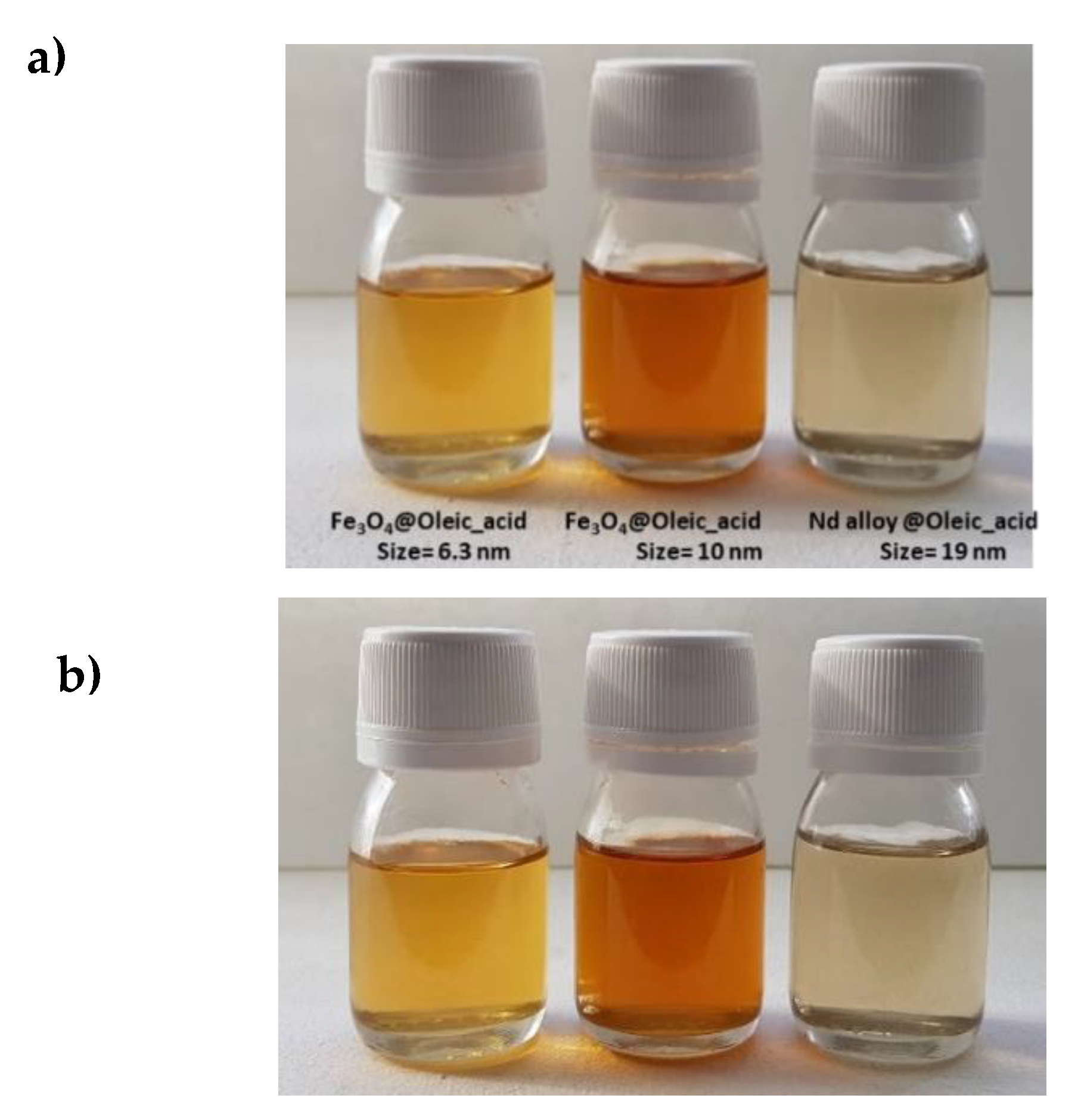


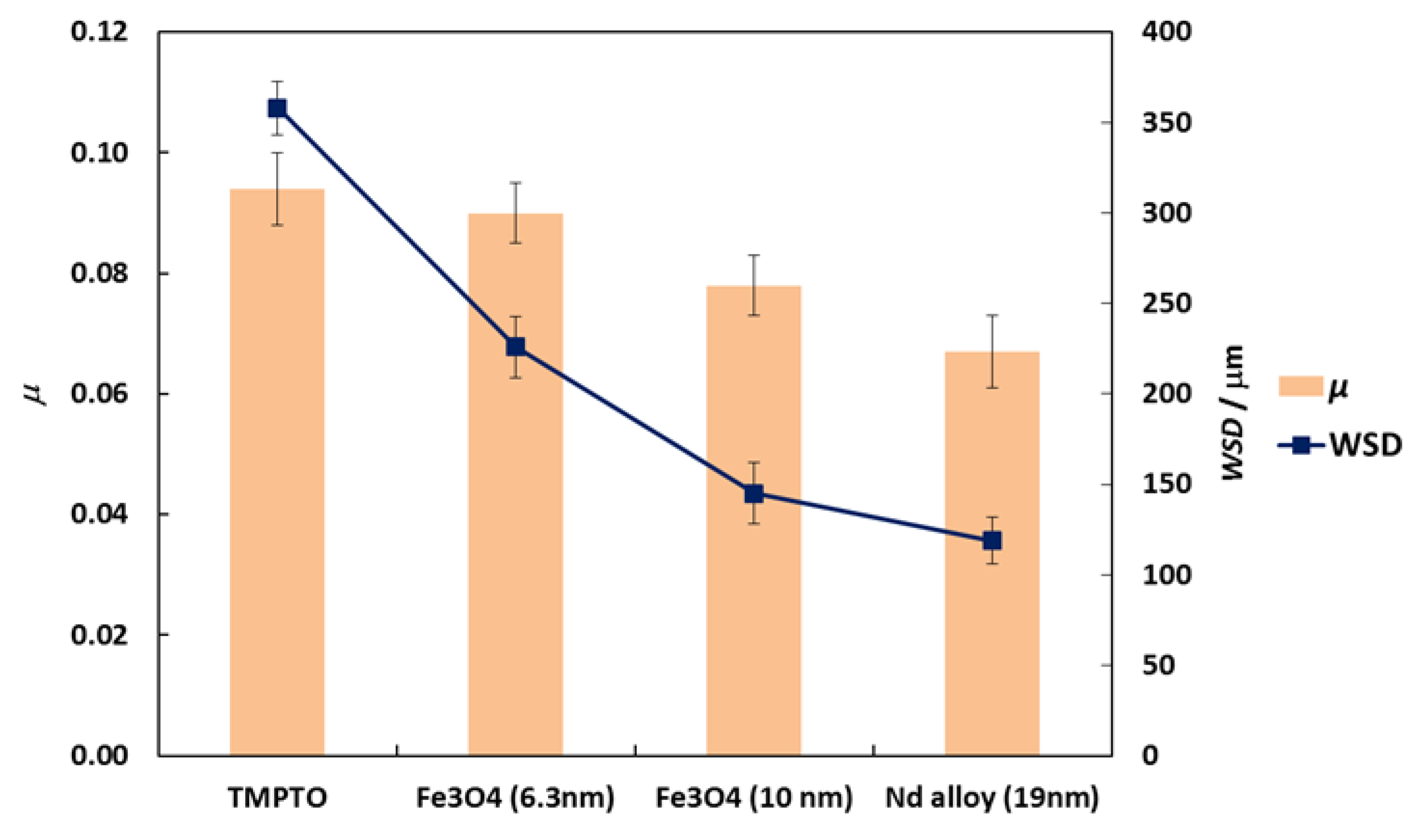

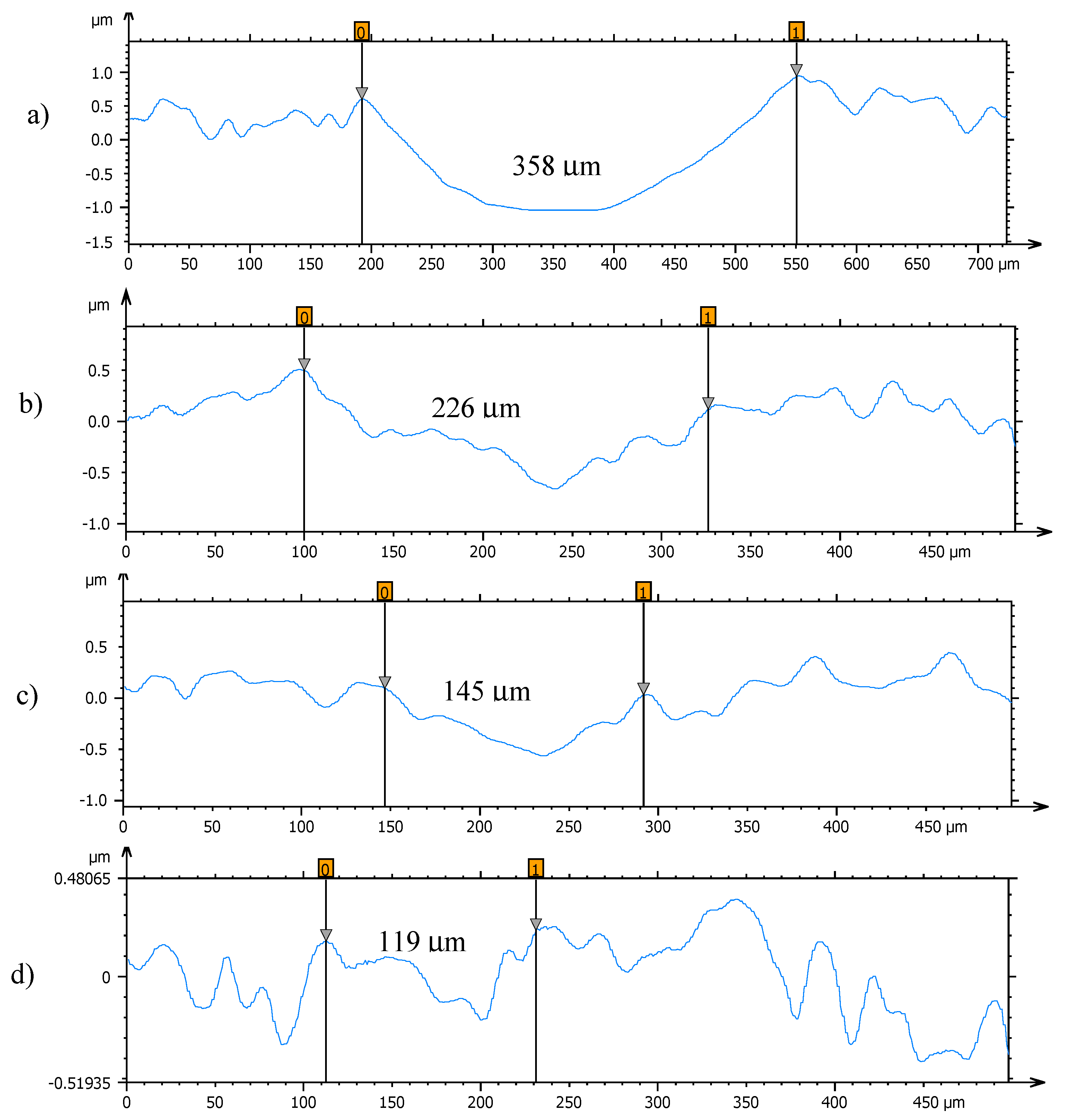





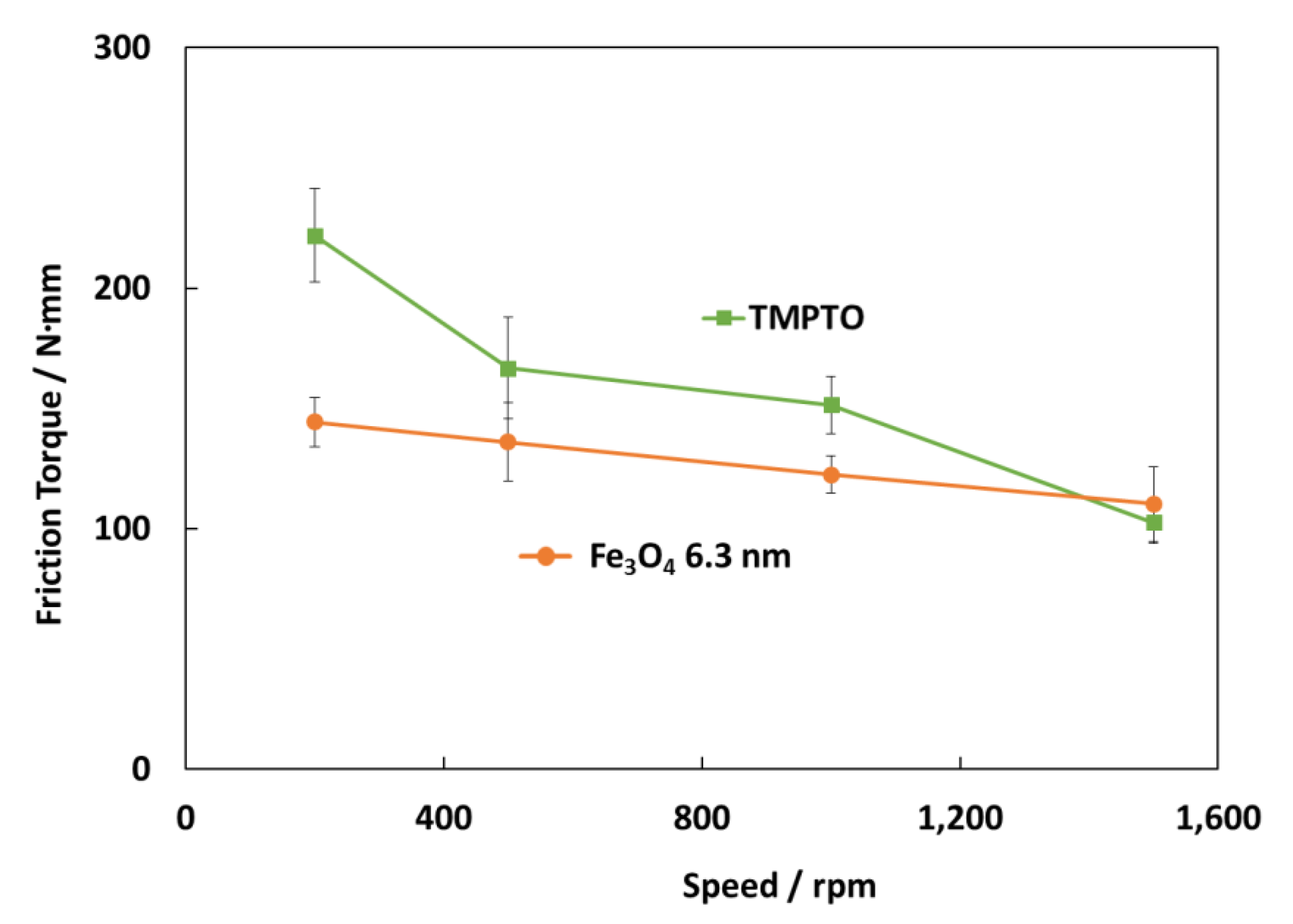
| Sample | Oleic Acid Content (wt%) | Number of Oleic Acid Molecules per NP Surface Area in nm2 |
|---|---|---|
| Fe3O4@OA (6.3 nm) | 29.10 | 5 |
| Fe3O4@OA (10 nm) | 19.30 | 6 |
| Nd alloy | 14.45 | 1 |
| Physical Property | TMPTO Base Oil | 0.015 wt% (Fe3O4-6.3 nm) | 0.015 wt% (Fe3O4-10 nm) | 0.015 wt% (Nd alloy-19 nm) |
|---|---|---|---|---|
| Density at 293.15 K/g cm−3 | 0.9161 | 0.9172 | 0.9167 | 0.9177 |
| Viscosity at 313.15 K/mPa s | 45.32 | 46.04 | 45.81 | 46.22 |
| Parameters | Ball | Glass Disc | Steel Disc | |
|---|---|---|---|---|
| Polished | Rough | |||
| Elastic modulus/GPa | 210 | 75 | 210 | |
| Poisson ratio | 0.29 | 0.20 | 0.29 | |
| Radius/mm | 19.05 | 50 | 50 | 50 |
| Surface roughness, Ra/nm | 20 | 5 | 50 | 500 |
| Lubricant | µ | σ | WSD/μm | σ/μm | WTD/μm | σ/μm | Vol/103μm3 | σ/103μm3 |
|---|---|---|---|---|---|---|---|---|
| Neat TMPTO | 0.094 | 0.006 | 358 | 15 | 1.57 | 0.11 | 58.1 | 3.4 |
| Fe3O4 (6.3 nm) | 0.090 | 0.005 | 226 | 17 | 1.52 | 0.21 | 23.7 | 1.1 |
| Fe3O4 (10 nm) | 0.078 | 0.005 | 145 | 17 | 1.17 | 0.13 | 13.7 | 0.8 |
| Nd alloy (19 nm) | 0.067 | 0.006 | 119 | 13 | 1.02 | 0.11 | 0.56 | 0.5 |
| Lubricant | Ra/nm | σ/nm | Gaussian Filter/mm |
|---|---|---|---|
| TMPTO | 60.9 | 5.2 | 0.08 |
| TMPTO + 0.015 wt% Fe3O4 (6.3 nm) | 47.9 | 4.1 | 0.08 |
| TMPTO + 0.015 wt% Fe3O4 (10 nm) | 41.8 | 4.2 | 0.08 |
| TMPTO + 0.015 wt% Nd alloy (19 nm) | 37.3 | 3.8 | 0.08 |
© 2020 by the authors. Licensee MDPI, Basel, Switzerland. This article is an open access article distributed under the terms and conditions of the Creative Commons Attribution (CC BY) license (http://creativecommons.org/licenses/by/4.0/).
Share and Cite
Liñeira del Río, J.M.; López, E.R.; González Gómez, M.; Yáñez Vilar, S.; Piñeiro, Y.; Rivas, J.; Gonçalves, D.E.P.; Seabra, J.H.O.; Fernández, J. Tribological Behavior of Nanolubricants Based on Coated Magnetic Nanoparticles and Trimethylolpropane Trioleate Base Oil. Nanomaterials 2020, 10, 683. https://doi.org/10.3390/nano10040683
Liñeira del Río JM, López ER, González Gómez M, Yáñez Vilar S, Piñeiro Y, Rivas J, Gonçalves DEP, Seabra JHO, Fernández J. Tribological Behavior of Nanolubricants Based on Coated Magnetic Nanoparticles and Trimethylolpropane Trioleate Base Oil. Nanomaterials. 2020; 10(4):683. https://doi.org/10.3390/nano10040683
Chicago/Turabian StyleLiñeira del Río, José M., Enriqueta R. López, Manuel González Gómez, Susana Yáñez Vilar, Yolanda Piñeiro, José Rivas, David E. P. Gonçalves, Jorge H. O. Seabra, and Josefa Fernández. 2020. "Tribological Behavior of Nanolubricants Based on Coated Magnetic Nanoparticles and Trimethylolpropane Trioleate Base Oil" Nanomaterials 10, no. 4: 683. https://doi.org/10.3390/nano10040683
APA StyleLiñeira del Río, J. M., López, E. R., González Gómez, M., Yáñez Vilar, S., Piñeiro, Y., Rivas, J., Gonçalves, D. E. P., Seabra, J. H. O., & Fernández, J. (2020). Tribological Behavior of Nanolubricants Based on Coated Magnetic Nanoparticles and Trimethylolpropane Trioleate Base Oil. Nanomaterials, 10(4), 683. https://doi.org/10.3390/nano10040683







